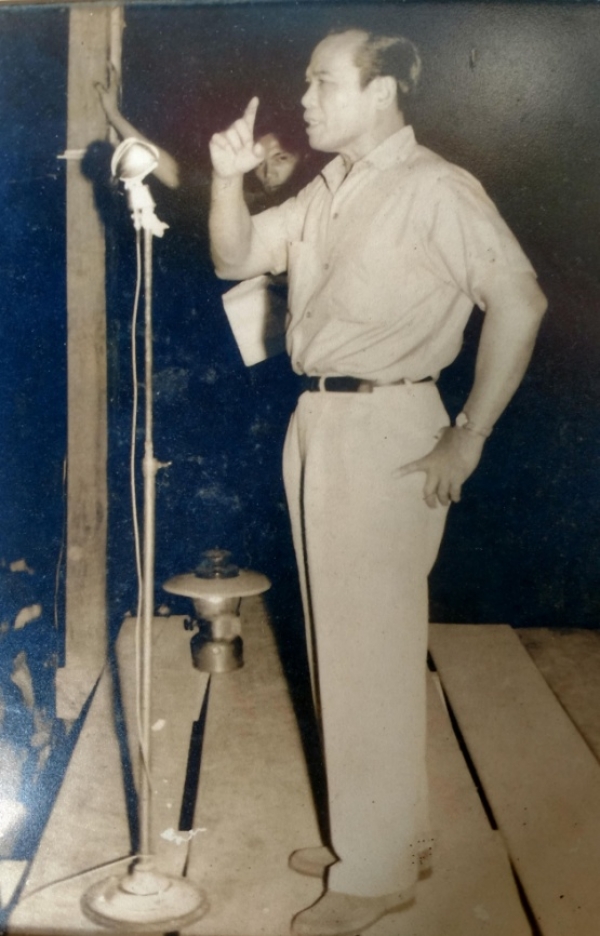Philippines : Labor hero 'Ka Bert' Olalia remembered
remains a familiar fixture in militant workers’ rallies in a country where labor leaders are typecast as macho, if not gangster-type characters.
‘I just want to emulate what the late Ka Bert had taught us,” she said, referring to the late founding chairman of the Kilusang Mayo Uno (KMU), the fiery nationalist labor leader who once championed not only equitable workers rights, but openly challenged the traditional “rice and fish unionism” by rallying workers to participate in the political struggle.
“He (Olalia) would always tell us that our workers can only be free (from their bondage) if our country is free,” said Gonzaga, the KMU’s vice president for women. She had the privilege of being Ka Bert’s long-time aide, since the day she started as his secretary at the National Federation of Labor Unions (NAFLU) in 1962.
In his lifetime, Olalia was himself a controversial figure in the labor movement.
He led the resurgence of the militant workers' movement, which triggered what were described as political labor strikes - paralyzing industries during martial law. These subsequently angered big capitalists who branded Olalia – a known socialist – and his band of labor organizers as “communists.”
Ka Bert Olalia
Yet on the day he was laid to rest on Dec. 4, 1983, the nation witnessed one of the biggest funeral processions ever. It turned into a protest march against the strongman Ferdinand Marcos. This was just a little over three months after the assassination of Mr. Marcos’ arch critic, then opposition leader Benigno Aquino Jr.
With his militant stance, the tough-talking, but charismatic labor leader had been in the forefront of the anti-dictatorship protest movement.
Olalia, then 79, died of rheumatic heart disease and pneumonia on Dec. 4, 1983, or nine months after he was incarcerated on charges of subversion in the massive crackdown on the militant labor movement by authorities. President Marcos only freed Olalia from jail when his heart condition deteriorated.
His supporters blamed Mr. Marcos for his death. “Prison life had been too harsh for the old man,” journalist Gloria Esguerra Melencio wrote after Olalia’s death.
Although he had been honored as one of the martial law heroes, he continued to be hounded by certain people whom his supporters described as having an “ideological anti-worker bias,” many of them retaining their influence even after the downfall of the dictatorship in 1986.
It was said that this was the reason Olalia was finally conferred the honor of being one of the “freedom advocates” only in 2014, when his name was incribed at the Bantayog ng mga Bayani, along with his son Rolando “Ka Lando.”
Ka Lando succeeded the elder Olalia as KMU chair after his death, only to be brutally murdered eight months after the Marcos dictatorship was toppled and a few months into Corazon Aquino’s presidency.
Surge of ‘nationalist’ unions
Ka Bert Olalia was eventually honored after the lapse of many years, even if he was known to have modeled himself after fellow unionist Crisanto Evangelista, the founder of the old Partido Komunista ng Pilipinas, who died in the hands of the Japanese during World War II for refusing to support the new colonizers.
As a young labor leader before the war, Olalia joined rallies fighting for independence from the United States. In those rallies, organized labor also called for eight-hour workdays, when the standard then were 12-hour workdays.
Born to a poor peasant family in Bacolor, Pampanga, Olalia experienced the harsh life of the lowly worker at age 13 when his family moved to Manila and he worked as an apprentice in a shoe factory. It was here that Olalia was introduced to unionism.
Four years later, as messenger of the Chineleros y Zapateros de Filipinos, he rose from the ranks to become the union secretary and eventually its president.
Olalia then helped organize the Katipunan ng mga Anakpawis (KAP), a federation of labor unions where he became general secretary. He later helped Evangelista organize the Collective Labor Movement, where he was elected vice president in 1938.
Ka Bert joined the resistance movement during World War II, leading several squadrons of the communist-led Hukbong Bayan Laban sa Hapon (Hukbalahap).
As a PKP member, and secretary for the Manila-Rizal Bureau, Olalia first led the Hukbalahap’s Manila squadron. When the Japanese killed Evangelista, Olalia helped Vicente Lava escape from his Tanay detention to replace the martyred PKP leader.
With the liberation of Manila, Olalia immediately organized a Labor Day rally on May 1, 1945 and later the Congress of Labor (CLO).
After rejecting the US grant of independence in 1946, Ka Bert helped rebuild labor unions and resumed agitating for reforms.
It was during this time that he confronted the “adventurist line “ of Lava, triggering his expulsion from the party and forcing his resignation from the CLO.
Olalia then formed the Katipunan ng Kaisahang Manggagawa (KKM), where he became president in 1948.
Detained
In the 1950s Ka Bert and fellow unionist Amado V. Hernandez were detained on rebellion charges.
After his release in 1957, he helped organized the National Federation of Labor Unions. As NAFLU president, he refused to coalesce with the Trade Union Congress of the Philippines when it was organized with the help of government as a labor center, He eventually led the founding of the KMU.
“Although he was a firebrand and a strict disciplinarian, Ka Bert had shown his dedication by leading a simple life. It was during those early years that I saw Ka Amado deliver his speeches with emotional verses,. That was how our leaders then gained respect," recalled Nitz Gonzaga.

Nitz Gonzaga at the workers rally
It was also through Ka Bert, Gonzaga added, that she learned a vital lesson: if they were to succeed in collective negotiations and in their strikes, they need to involve the communities and other sectors.
When she was still an office worker, Gonzaga said she saw how Olalia involved his eldest son Mando and Ka Lando as his trusted lieutenants in union work.
She once asked Ka Bert why he had forced his sons to assist him in union work and lead a spartan life like him. The elder Olalia reportedly replied: “There’s really gold in labor. We encounter labor leaders who are lawyers who act like lawyers, but would later connive with management. But my sons, I can always control them.”
One afternoon, Gonzaga said she even overheard the elder Olalia telling Ka Lando, “you need to study law, but if you cheat them (the workers) I will kill you.”

Atty. Rolando Ollalia
Ka Lando completed his law studies at the Manuel L. Quezon University before martial law was declared in 1972, and became the NAFLU’s legal counsel.
After being elected to lead the KMU , Ka Lando also chaired the Partido ng Bayan, the left-wing political party organized after the 1986 EDSA revolt, and participated in the first national elections in 1987.
But it was his successor, the late Crispin Beltran, or Ka Bel to his generation of unionists, who would be the first KMU member of the House of Representatives.
A legacy of political struggle
Elmer Labog had been in union work since the late 70s, but he got the chance to work with Ka Bert only after his arrest in 1982.
Authorities were apparently alarmed by the growing militancy and political transformation of the trade unions after Olalia successfully unified the once fractious leftwing unions during the KMU's full-packed first national congress at the Araneta Coliseum.
“They (authorities) thought they can neutralize the KMU without Ka Bert, but they were wrong,” said Labog, who was leading a local hotel union when he decided to work full-time as a KMU organizer on learning that most of the militant leaders had been incarcerated.

KMU chair Elmer Labog
“Before the KMU, all unions were the same. But with the founding of the KMU, Ka Bert was able to differentiate the ‘yellow unions’ from the genuine unions who would work for the interest of the workers,” Labog pointed out.
Now at the helm of the KMU, Labog admitted that while conservative trade unions continue to dominate organized labor, the KMU’s nine labor federations that were organized by Ka Bert remain intact. From being a Manila-based labor center, they now have organized unions nationwide.
Meanwhile, Bayan Muna Rep. Carlos Isagani Zarate lamented that heroes from the working class like the Olalias have not been properly honored.
It was really unfortunate, he said, that while these people championed the rights of the downtrodden, a surge in historic revisionism made it possible to resurrect known plunderers who still dominate the national landscape.
Nevertheless, Zarate said Ka Bert has doubtless found his niche in the labor movement by being an inspiration to present day unionists – and militants -- who continue to assert the workingmen’s rights to job security and better living and working conditions.




